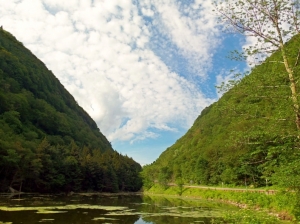Clove encounter
On the Rocks
The Woodstock Times
April 10, 1997
Revised by Robert and Johanna Titus
It can often be difficult to teach a science, even one as interesting as geology. Many people are adverse to the sciences. One problem is that a lot of people really would rather not know the technical details behind some remarkable piece of nature. They believe it’s better to harbor romantic images and not spoil them with harsh factual science. Let’s try this out at Stony Clove.
Stony Clove is a magnificent sight to see. It is a very steep, very narrow notch in the Central Escarpment of the Catskills. It is a remarkably scenic location, especially in the autumn when the leaves are in color and when the lake there reflects their image. A person might very well be tempted to not want to know too much about the notch. How could the science improve upon such natural beauty?
Maybe science is the wrong word to start out with. A better word is mystery. What is this wonderful notch and how did it come to form here? That sounds better, and if the mystery of Stony Clove catches your interest, then it must be the science of the site which will solve that mystery. Certainly no geologist can pass such a landscape feature without wondering how it came to be, and there is quite a story behind the notch, one that takes us back into the ice age.

When you get a chance, travel to Stony Clove. As you approach the top of the clove on Rte. 212 from the south, there is a lake to your left. Beyond that is the clove. Park in the lot next to the lake and hike north to the top of clove. In your mind’s eye go back 17,000 years. It’s a time in the history of Catskill Mountain glacial history called the Wagon Wheel Ice Margin. From the Hudson River, valley glaciers have advanced up Plattekill and Kaaterskill Cloves. Some of this ice has turned south and entered into Stony Clove. From the crest of the clove you can picture this glacier; it’s just to the north. Its front is a mess, a jumble of broken blocks of ice. There is a small lake at the base of the glacier. Its waters reach up to your feet. All along the front of the ice where it bounds the lake, great masses of water are welling upward and the surface of the lake is churning with turbulence. It’s evident that the climate has been warming and the ice is melting. The glacier is disintegrating and from time to time one or another of those blocks of ice proves unstable and collapses into the lake with a violent crash. With that, a tidal wave radiates quickly across the lake. It’s a big wave in a small lake so the agitation is immense; a lot of that water spills over the crest of the notch.
In your mind’s eye look back south, down the valley from the crest. With all that melting, there is only one place for all the water to go and that is in this direction. Stony Clove is a great, loud, cataract of raging, foaming, pounding white water racing down the valley. The strength of the flow is manifest in the cracking sound of tumbling, colliding boulders. Competing currents of water crisscross around the largest boulders and collide with each other sending white fountains into the air. The hissing spray catches the sunlight and forms rainbows.
Many of the most powerful currents abut the stream bank. Where this occurs muddy gravels collapse into the flow and this sediment is rushed away. Beneath the white surface, the water is brown with erosion. It’s this scouring that has carved the great notch in the mountain.
On a quiet summer or autumn day Stony Clove can be a site of serene natural beauty, a quiet place to picnic or just sit and gaze. But the serenity is deceptive; there is real violence in the clove’s origins. You can’t really understand Stony Clove unless you understand its past. You have to use your mind’s eye and you need to know its geology to do that. This is the science of it all.
Contact the authors at randjtitus@prodigy.net. Join their facebook page “The Catskill Geologist.”





